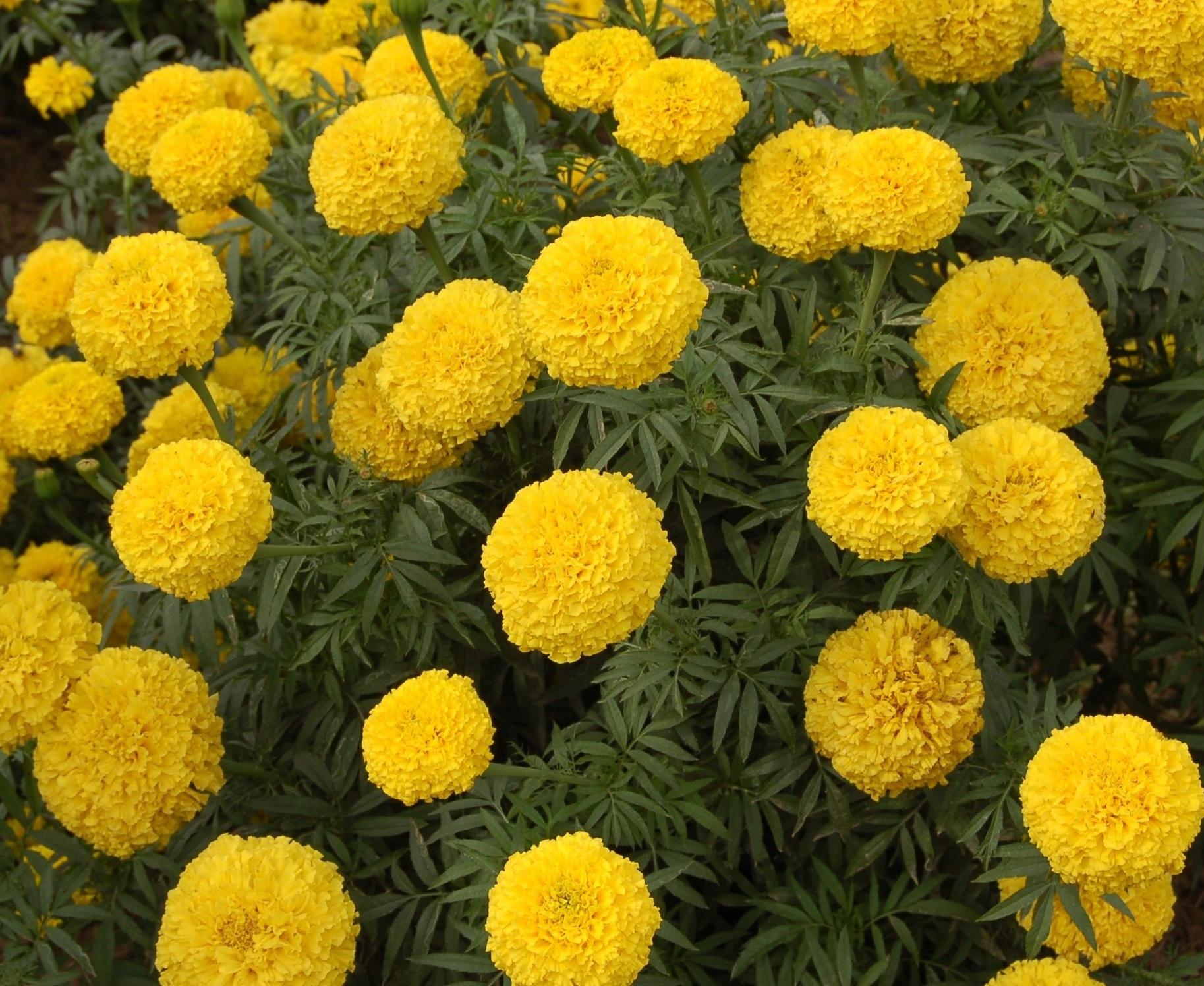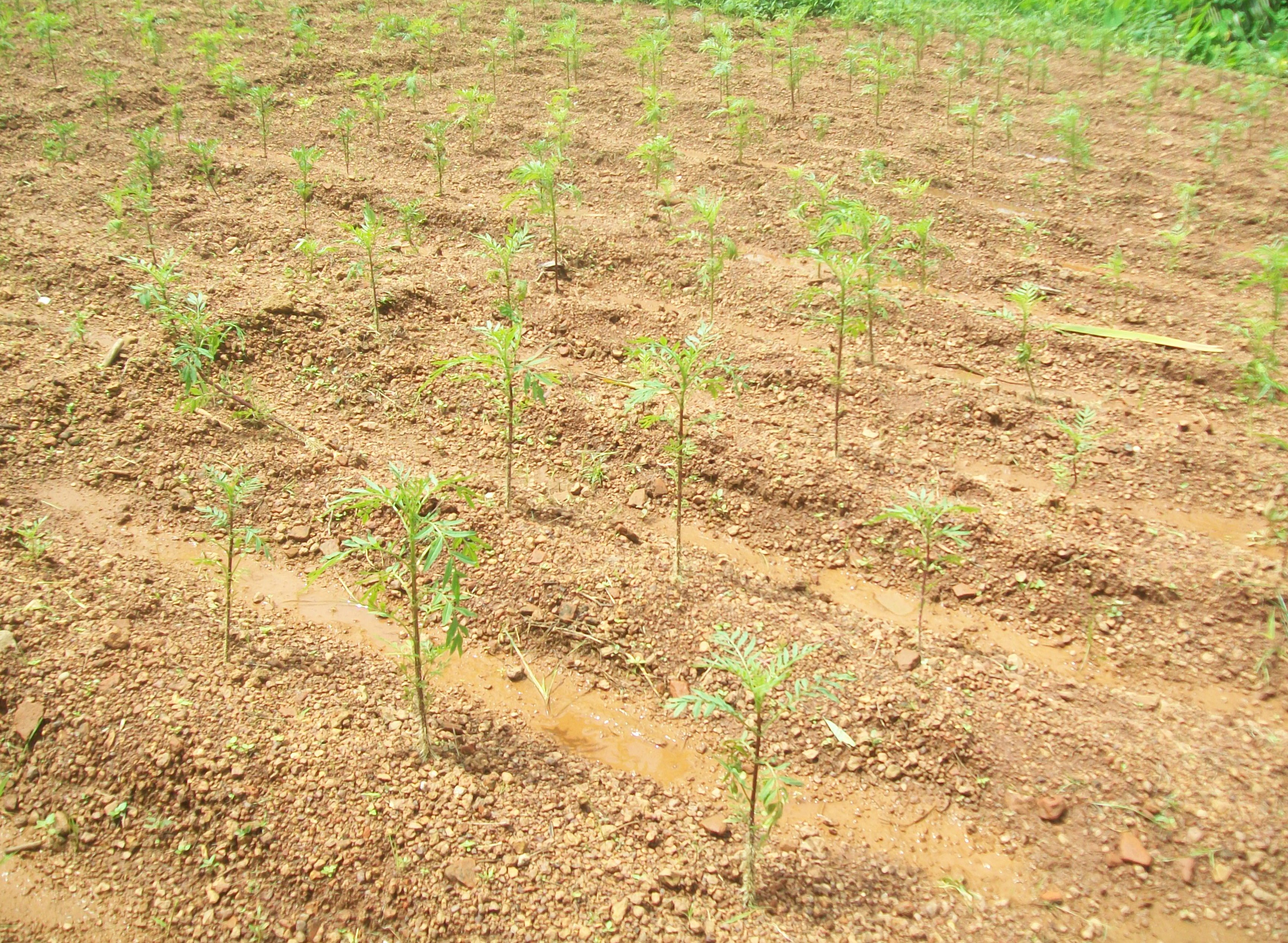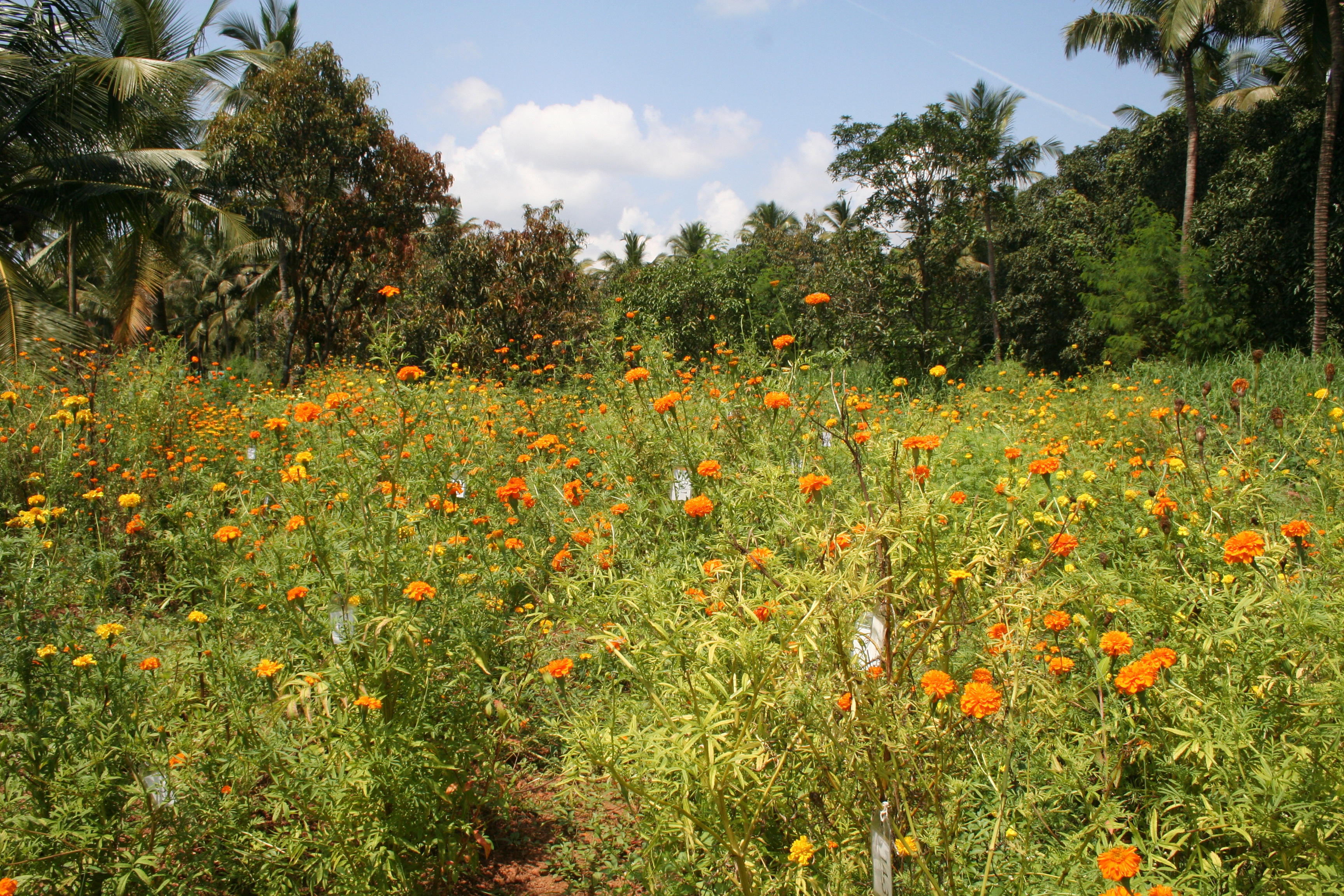
Crop: AFRICAN MARIGOLD
Scientific name : Tagetes erecta L.
Common / Local Name :
African marigold is a popular flower crop grown throughout the world on commercial scale. Marigold stands first among the loose flowers in Goa and its requirement increases many folds on special occasions like Ganesh Chathurthi, Dussera, Diwali, weddings etc. Flowers are extensively used in the preparation of garlands and as loose flower on the occasion of religious ceremonies, festive occasions, offerings etc. Apart form loose flowers, carotenoids extracted from flowers are used for industrial purpose. It is being used commercially in pharmaceuticals, food supplements, animal feed additives and colorants in food and cosmetics .The commonly cultivated species of marigold are African marigold (Tagetes erecta) and French marigold (Tagetes patula).
A wide range of soils with provision for good drainage is suitable for cultivation of marigold. Soil pH should be 6.0-7.5. Saline and acidic soils are not suitable for cultivation.
Local types (orange & yellow), Pusa Narangi Gainda, Pusa Basanthi Gainda (IARI varieties), MDU 1 etc


Seeds are used for raising the crop. Seed rate is about 1.5 kg seeds/ha
Preparation of nursery bed
The soil of bed should be prepared with fine tilth. Prepare nursery beds of 75 cm width, 10-20 cm height and of convenient length. Apply sufficient quantity of farm yard manure and mix them properly with the soil. Sowing of the seeds should be done in rows spaced 5 cm apart. The depth of sowing should not exceed 2-3 cm. Cover the seeds with mixture of fine sand and irrigate lightly with rose can. The nursery beds are to be covered with paddy straw. Watering at initial stage should be done with watering can at alternate days. The seeds germinate 4-5 days after sowing. The seedlings will be ready for transplanting one month after sowing.
Main field preparation
For the main-field, the land should be ploughed well, pulverised and FYM @ 20 t/ha should be incorporated to the soil. The field should be given pre-plant irrigation. Apply a basal dose of fertilizers @ 125 kg N, 100 kg P2O5, and 100 kg K2O per ha. Transplanting should be done over the ridges as Goa is a high rainfall area. Transplant the seedlings at a spacing of 45 x 30 cm in case of French marigold and 60 x 45 cm in case of African marigold on one side of the ridge. Light irrigation should be done immediately after transplanting. Top dress the crop with 125 kg N per ha 30 days after transplanting followed by earthing up.

Pinching
Pinching should be done 30-45 days after transplanting or before bud formation. Pinching is done for making the plants bushy and to increase the total yield. It consists of removing terminal portion of the plant. Pinching will help in breaking of apical dominance mechanically to promote laterals and increase the number of flowers and flower yield. Since plants of marigold have a strong tendency of apical dominance, pinching plays a vital role.
Irrigation
Irrigation should be done once in a week or as and when necessary. Water stagnation should be avoided.
After cultivation
Weeding should be done as and when necessary. For good growth, 3-4 manual weedings are required.
Plant protection
As such marigold is a hardy plant and hence pest and disease attack is less frequent. Drenching of nursery beds with Copper oxychloride at seedling emergence stage will prevent damping off in seedlings.
Aphids:
These are small insects green to bluish-grey or black in colour. These usually occur in clusters and damage the apical growing portion by sucking the plant sap. Infected plants become weak and unproductive. Spraying of Monocrotophos 0.05%, Phosphamidon 0.02%, or Dimethoate 0.03% at 10-15 days interval helps to check the population of the aphids.
Beetles and Weevils:
These feed on young leaves and tender shoots, particularly at the ground level. Spraying of systemic insecticides like Rogour or Monocrotophos @ 2 ml/ litre of water on the under surface of the leaves effectively controls the insects.
Leaf Hoppers:
Leaf hoppers cause considerable damage to the foliage of the plant, particularly during rainy season. The symptom appears as rolling and curling of leaves along with wilting of shoots. French marigold is more susceptible than African type. The pest is effectively controlled by two to three sprayings of Methyl Parathion or Quinalphos (0.05%).
Red Spider Mites:
These are spinning creatures, red and brown in colour. The mites become active during the flowering period. They suck the sap from the leaves. The speckling, discoloration and dusty appearance of the leaves easily identify the attack. Spraying of miticides like Kelthane (2 ml/litre of water) or Dicofol (0.1%) is effective against the mites.
Wilt and Stem Rot (Phytophthora cryptogea) :
The fungus affects the collar portions of the plants. In nursery the infection results in damping-off and is aggravated by soil moisture. In the field the infected plants show wilting. French marigold and dwarf varieties are less susceptible whereas the African types are highly susceptible to the disease. The disease may be controlled by soil treatment with Captan, Mancozeb, Metalaxyl and Fosetyl-Al.
Collar Rot (Phytophthora sp.; Pythium sp.):
The symptoms are in the form of black lesions developed on the main stem. Rotting at the collar regions causes death of the plant. Soil sterilization and controlled watering help in reducing the disease incidence.
Leaf Spot and Blight (Alternaria, Cercospora and Septoria sp.):
Brown necrotic spots develop on leaves, which get enlarged at the later stage of infection. The entire foliage gets damaged and results in poor vegetative growth. Spraying of fungicides is helpful in controlling the disease.
Powdery Mildew (Oidium sp.; Leveillula taurica):
The symptoms are in the form of whitish powdery growth on the aerial parts of the plant. Spraying Sulfex (3g/litre of water) can effectively control the disease.
Flower Bud Rot (Alternaria dianthi):
The fungus infects the young flower buds. The infected buds shrivel and become dark brown in colour. The pathogen also infects leaves causing blight. The infection is visible in the form of brown necrotic spots on margins and tips of older leaves. Spraying of Mancozeb (2g/litre of water) effectively controls the flower bud and leaf infections.
Damping off (Pythium sp.):
The disease is most prevalent at the seedling stage. Necrotic spots and rings develop on the young seedlings causing collapse of the seedlings. Considerable loss is sustained if seedlings are not properly looked after. Spraying of Dithane Z-78 @ 2g/ litre of water are effective in controlling the disease.
Marigold flowers will be ready for harvest in about 21/2 months time from the date of transplanting.


The plant continues to bear flowers for another 2-21/2 months from the date of first harvest. The flowers are harvested when they have attained full size. Picking should be done once in 3 days along with a portion of stalk. The approximate yield is about 80 quintals per hectare per season through several plucking.
Input availability |
Address/Contact details |
| Seeds |
|
Fertilizers |
|
Pesticides |
|
| Machineries |
|
|